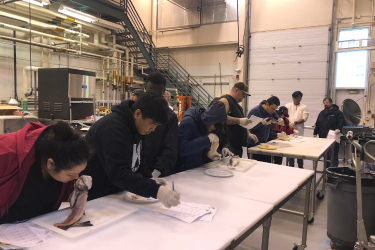The harvest of brown shrimp in the western Gulf of Mexico is expected to be 40.6 million pounds, which is below the historical 58-year average of 56.0 million pounds, according to NOAA’s annual forecast. The prediction covers the period from July 2019 through June 2020 for state and federal waters off Louisiana and federal waters off Texas.
Although local environmental factors (temperature, rainfall amounts, and tidal heights) should have contributed to favorable conditions for brown shrimp recruitment and growth in Texas, freshwater inflow into Galveston Bay (on which the forecast model is based) from the Trinity River watershed resulted in salinities near zero in much of the bay. Subsequently, the availability of suitable nursery habitat was limited to West and Lower Galveston Bay. Likewise, growth may have been affected by the lower salinities.
Similarly, early spring temperatures in Louisiana would have suggested favorable conditions for an average production. However, Louisiana was inundated with freshwater runoff due to unprecedented Mississippi River flows this spring. These freshwater events have offset the early spring favorable conditions to a much less favorable environment for brown shrimp production.
NOAA scientists make the annual prediction of brown shrimp catches based on monitoring of juvenile brown shrimp abundance, growth estimates and environmental indicators. They predict shrimp catches for state and federal waters off Louisiana from west of the Mississippi River to the Texas–Louisiana border to be approximately 21.3 million pounds this season. The Texas portion of the catch is predicted to be 19.3 million pounds.
Most of the shrimp harvested in the U.S.—77 percent—comes from the Gulf of Mexico, especially Texas and Louisiana. Total domestic shrimp harvest brought in $531.0 million in 2017.
Young brown shrimp begin entering estuaries in Texas and western Louisiana in mid-February and continue through July, with peak recruitment occurring from February through early April.
A wide array of environmental and biological factors affects the fate of young shrimp entering the estuaries. Three environmental variables: temperature, salinity, and tidal height, have been correlated with subsequent shrimp production.
Juvenile brown shrimp abundance and growth estimates are obtained by monitoring the inshore commercial shrimp fisheries in Texas and the inshore and nearshore fisheries in Louisiana. Data for these forecasts are obtained from NOAA Fisheries Galveston Laboratory, NOAA port agents, NOAA’s National Climatic Data and Weather Centers, Texas Parks and Wildlife Department, and the commercial shrimp industry.


